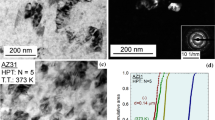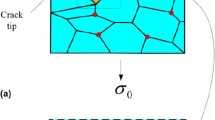Abstract
The mechanical properties of grain boundaries (GBs) and the development of grain-boundary sliding (GBS) were studied in the pure Zn using precision microindentation technique, optical, electron and atomic-force microscopy. Results have shown the different dependencies of the microhardness values on the indentation depth for GBs and individual grains. When the size of the plastic zone around the imprint was comparable to the grain size, GBs acted as barriers for dislocation sliding bands and twins. With applying the higher load, more grains were involved in the process of deformation, but microhardness did not increase. That was explained by the activation of GBS, leading to the relaxation processes. In its turn, the microhardness values measured at low loads in the vicinity to GBs and triple junctions (TJs) were higher than those measured in the grain interior. Thus, movement of the ensemble of defects to the GBs during microindentation is the activating factor for GBS in polycrystalline Zn. At the same time, during spreading of the deformation at low loads in the vicinity to GBs the activation of GBS was not observed.








Similar content being viewed by others
References
Gleiter H, Chalmers B (1972) In: High-angle grain boundaries. Pergamon press, Oxford, p 303
Sutton AP, Baluffi RW (1995) In: Interfaces in crystalline materials. OUP, Oxford, p 856
Langdon TG (2006) J Mater Sci 41:597. doi:https://doi.org/10.1007/s10853-006-6476-0
Esquil EV, Murr LE (2005) Mater Sci Eng A 409:13
Meyers MA, Mishra A, Benson DJ (2006) Nanotechnology April:41
Shen Y-L, Abell KCR, Garrett SE (2004) Damage Mech 13:225
Pervezentsev VN, Ribin VV, Chuvil’deev VN (1992) Acta Met Mater 40:887
Lagow BW, Robertson IM, Jouiad M, Lassila DH, Lee TC, Birnbaum HK (2001) Mater Sci Eng A309–310:445
Leae TC, Robertson IM, Birnbaum HK (1990) Phil Mag A 62:131
Gouldstone A, Chollacoop N, Dao M, Li J, Minor A, Shen Y-L (2007) Acta Mater 55:4015
Sheikh-Ali AD, Valiev RZ (1994) Mater Sci Forum 170–172:1017
Muktepavela F, Maniks J (2002) Interface Sci 10:21
Braunovic M (1973) In: Westbrook JH, Conrad H (eds) The science of hardness testing and its research applications. ASM International, p 329
Hockey BJ (1973) In: Westbrook JH, Conrad H (eds) The science of hardness testing and its research applications. ASM International, p 21
Soifer YaM, Verdyan A, Kazakevich M, Rabkin E (2002) Scripta Mater 47:799
Soer WA, Aifantis KE, De Hosson JThM (2005) Acta Mater 53:4665
Ohmura T, Tsuzaki K, Yin F (2005) Mater Trans 46:2026
Aust KT, Hanneman RE, Niessen P, Westbrook JH (1968) Acta Met 16:291
Kobayashi S, Tsurekawa S, Watanabe T (2005) Acta Mater 53:1051
Sursaeva V, Straumal B (2005) Materialwiss Werkstofftech 36:528
Upit GP, Varchenya SA (1973) In: Westbrook JH, Conrad H (eds) The science of hardness testing and its research applications. ASM International, p 135
Durst K, Backes S, Goeken M (2005) Scripta Mater 52:1093
Yang B, Vehoff H (2007) Acta Mater 55:849
Varchenya SA, Muktepavel FO, Upit GP (1970) Phys Stat Sol (a) 1:K165
Nix WD, Gao HJ (1998) J Mech Phys Sol 46:411
Acknowledgements
This work was financially supported by the project INTAS (05-1000008-8120), Russian Foundation for Basic Research (06-0204015), and Latvian Science Council (grant number 05.1705).
Author information
Authors and Affiliations
Corresponding author
Rights and permissions
About this article
Cite this article
Muktepavela, F., Bakradze, G. & Sursaeva, V. Micromechanical properties of grain boundaries and triple junctions in polycrystalline metal exhibiting grain-boundary sliding at 293 K. J Mater Sci 43, 3848–3854 (2008). https://doi.org/10.1007/s10853-008-2465-9
Received:
Accepted:
Published:
Issue Date:
DOI: https://doi.org/10.1007/s10853-008-2465-9




